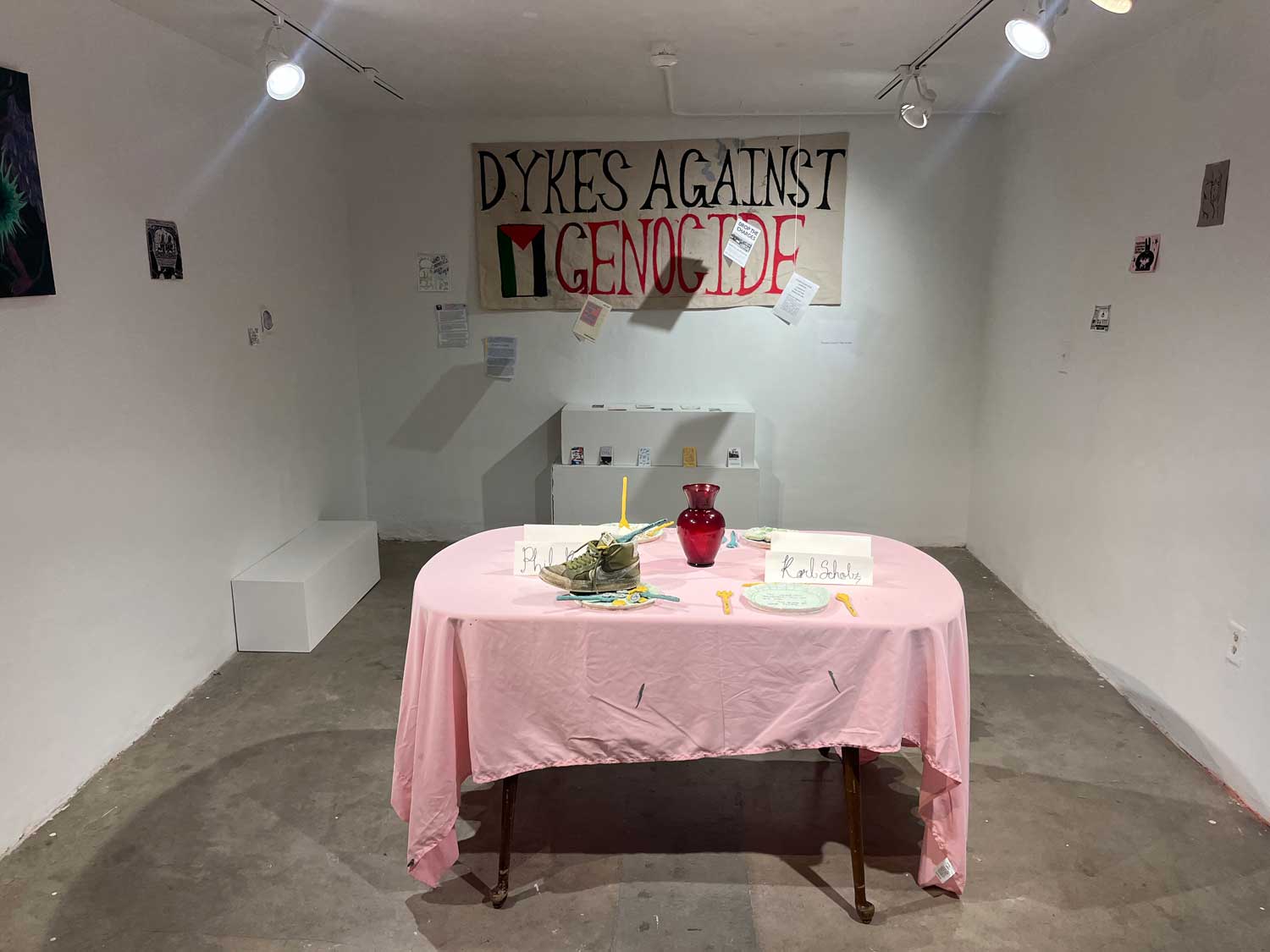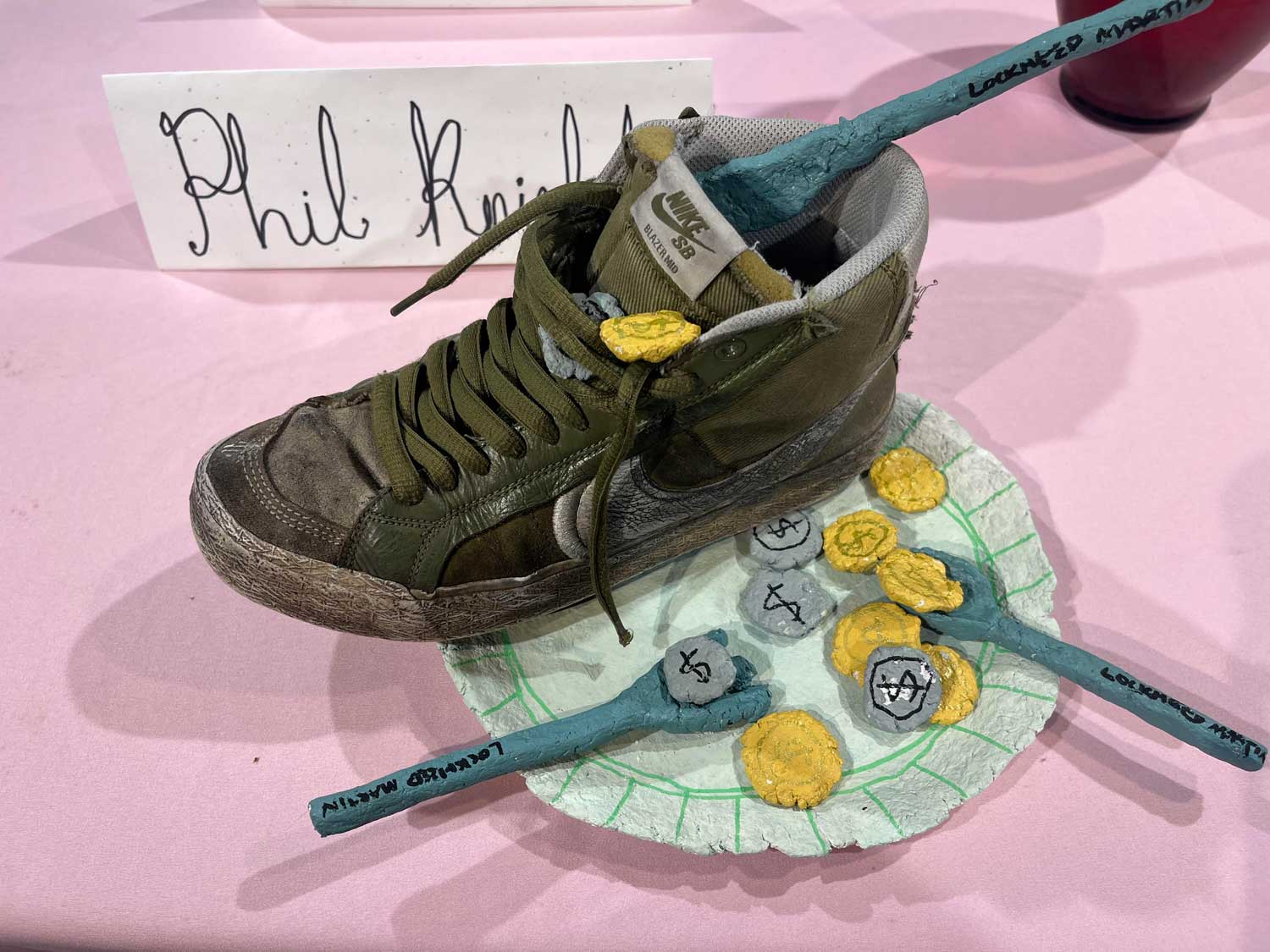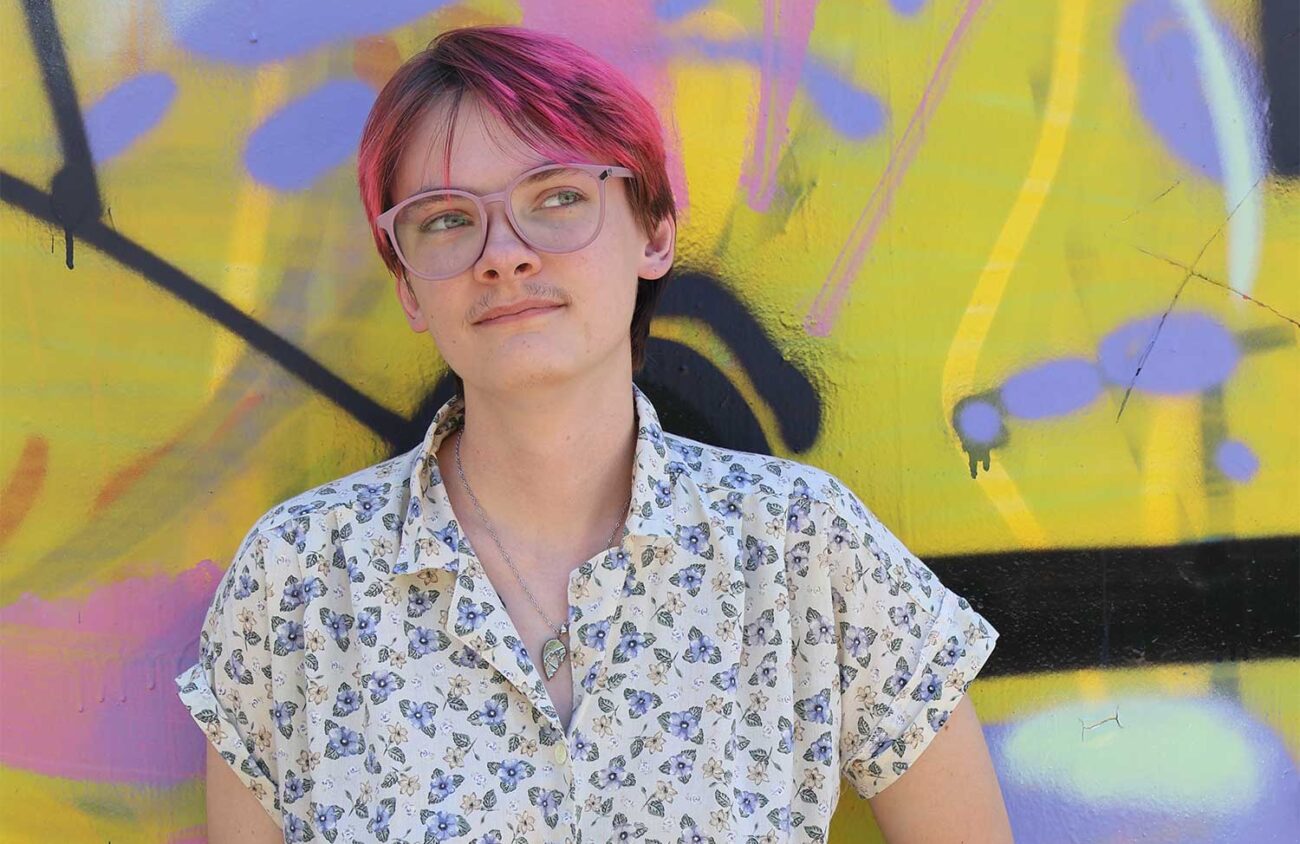Cassy Steuerwald’s art installation was titled “We Tried Throwing Them a Dinner Party.” It consisted of a small dining table with a pink tablecloth and place settings for University of Oregon President Karl Scholz, Nike billionaire and UO benefactor Phil Knight, and Adrian Parr Zaretsky, dean of the UO College of Design.
Tacked against the wall behind the table was a zine or pamphlet previously distributed on campus suggesting that Dean Parr Zaretsky, who is Jewish, is complicit in genocide in Israel’s war in Gaza.
The 21-year old psychology major, who is minoring in art, wanted to provoke a conversation. Now the artwork could get Steuerwald expelled.
Following a complaint from the dean of the College of Design, the UO is investigating the sophomore’s art installation, exhibited months ago, that the dean says constituted antisemitic harassment. The exhibit was up for less than a week in January in a difficult-to-access gallery space and seen by fewer than 10 people, according to the UO’s own investigation.
The months-long investigation opens serious questions about free speech on a public university campus and the lengths UO is willing to go to silence — and even punish — a single student for an artistic protest.
Documents from the investigation obtained by EW show the case may turn on how the university decides to define antisemitic speech, versus the presentation of criticism — accurate or otherwise — about a UO official’s support for Israel.
But news of the investigation surfaces as higher education officials have witnessed the Trump administration’s punishing tactics against colleges and universities that federal officials say swerved into antisemitism, especially during pro-Palestinian protests in the spring of 2024. Columbia University is paying more than $200 million to the federal government to settle Trump administration claims that it violated Title VI of the Civil Rights Act in the school’s handling of allegations of antisemitism.
When Eugene Weekly reached out to the UO for comment on the unusual investigation, a university spokesperson who asked not to be identified would say only that they could not comment on specific investigations.
EW also emailed Parr Zaretsky for comment. She declined an interview request, saying she was too busy, but asked for written questions to be sent.
In her emailed reply, Parr Zaretsky said the art exhibit was a part of a larger campaign of harassment she has suffered since the war in Gaza began. “The grievance at the heart of this process was submitted neither to undermine academic freedom nor to target or harm any student,” the dean said to one of five questions from EW. “Rather, it addressed a situation that was not isolated in nature, but part of a broader, coordinated pattern of antisemitic attacks and threats directed at me and others within the campus Jewish community following the events of October 7, 2023.”
Parr Zaretsky, who has been the dean of the College of Architecture, Planning and Public Affairs since 2021 is a recognized international expert on climate change politics and environmental justice, with a specific focus on water scarcity. She told investigators that she has become so frightened for her safety that she asked UO officials for additional security when she was on campus, a request that she says Scholz denied.
At the heart of Parr Zaretsky’s concerns is an eight-page zine — the UO and Parr Zaretsky call it a pamphlet — alleging Parr Zaretsky is complicit and supports Gazan genocide, something she strongly denies. The pamphlet was produced and distributed in 2024, before the installation, and was only a small part of the artwork. Stuerewald says while he copy edited the zine, he did not write it.
The complaint itself, though, specifies only the art exhibit. The dean did not answer more detailed questions, such as why a student should be forced to go through a lengthy investigation over an art show approved by a university exhibitions coordinator; why the UO exhibitions coordinator was not also the subject of the complaint; and what kind of message such an investigation sends to prospective students who might want to study art at the UO.
Steuerwald counters that he is the one being harassed for expressing the political belief that the UO is financially involved in the war in Gaza because of its investments in such corporations as Lockheed Martin and Boeing. It is not antisemitic, the student artist says, to oppose Israel’s invasion of Gaza.
Steuerwald — a trans person who walks with a cane due to back problems and who is a first-generation college student from Texas — presents a sympathetic figure under attack by a powerful administrator.
“My parents have sacrificed a lot to get me here,” Steuerwald says. “And they are very concerned about what’s going on.”

Steuerwald’s art installation was on exhibit from Jan. 13-17 in the small, one-room Washburn Gallery, which is little known among the university community or the broader public as it’s across Franklin Boulevard from the center of campus and requires a key card for entry. Steuerwald applied for and was given permission to mount the show, which the UO then promoted on social media.
On April 1, almost three months after the exhibition came down, Steuerwald received formal notice from the university of an investigation for possible violation of the Student Conduct Code. The dean, the notice says, “alleges that you submitted a proposal for an exhibition displayed in the Washburn Gallery that included a pamphlet that constituted harassment based on national origin and/or religion.” It also says the exhibition “included content that was sufficiently severe or pervasive that it substantially interfered with [the dean’s] university employment.”
The complaint, which does not suggest that Steuerwald was involved in previous threats or attacks, goes on to say that he could face “suspension or expulsion from the University.”
“It’s all very bizarre,” Steuerwald says. “I was very surprised by the whole thing. The art exhibit was up for four days with little fanfare.”
The university has hired a private firm from Ohio called INCompliance to conduct the investigation. INCompliance, according to its website, specializes in conducting civil rights investigations for educational institutions. So far the investigation has involved more than three hours of testimony from Steuerwald and has generated a 350-page evidence file.
Since receiving the official notice on April 1, Steuerwald says, life has been consumed by the lengthy investigation. “This case lasted through the entirety of my spring term,” Steuerwald says. “It has impacted my ability to do my school work. I definitely fell behind for a bit. My grades were slipping for most of the term. And every interview I’ve gone into with these investigators has been a fishing expedition.”
According to the documents obtained by EW, Steuerwald was repeatedly asked by the investigator to name other students involved in campus protests. He refused to do so.
Steuerwald says the UO had for months been seeking names of individuals organizing on-campus protests last year against the war in Gaza, and the art exhibit provided them a name — his. “The university is looking for students to punish, to shut them up,” the artist says.
Students being investigated for possible violations of the conduct code have the right to an outside advisor to help guide them through the process. Steuerwald’s advisor, retired UO professor of philosophy and law Cheyney Ryan, called the investigation “an abuse of the Student Conduct Code.” The UO spokesperson declined to discuss, even hypothetically, whether the Student Conduct Code could be abused.
After Ryan spoke with a reporter about the case, the university officially removed him as Steuerwald’s advisor in the proceedings, saying Ryan had violated confidentiality. An email sent the evening of Monday, July 28, by Nicole Commissiong, a university vice president who is the UO’s chief civil rights officer and Title IX coordinator, orders Ryan to destroy all records he has of the case and not to further discuss it with anyone. He is not even to talk about his own dismissal. “This action, like all other matters related to this investigation, is to remain confidential,” the email says.
Ryan posted news of his dismissal on Facebook a few hours after receiving the email.
“This investigation,” he said in an interview with EW the following morning, “is a total, utter waste of time.”
Steuerwald was shocked by the news that Ryan could no longer represent him. “It feels like he’s being removed for doing what I appointed him to do,” the student said. “They are trying to intervene in the process. I have a right to talk about it and have my advisor talk about it.”
In a separate email, Commissiong ordered Steuerwald not to talk any further to Ryan about the case, saying that doing so could constitute “retaliation” against the dean for her complaint. Steuerwald said he plans to ignore that order.
Student conduct investigations against students are confidential under federal law, even after the cases are concluded.
The case brought by the UO College of Design’s dean against a lone student’s art exhibit would have remained confidential if the student, Steuerwald, hadn’t chosen to speak out.

Ryan, who is also a senior research fellow at Oxford University’s Institute for Ethics, Law, and Armed Conflict, is personally sympathetic with Steuerwald’s situation. As an undergraduate at Harvard University in 1969, Ryan was expelled and banned from the Harvard campus for his role in that turbulent year’s occupation of Harvard’s University Hall by Students for a Democratic Society.
“It’s pretty astonishing,” he says of the UO dean’s current complaint and subsequent investigation. “Not only did [university officials] approve the exhibit, they promoted it on Instagram.”
Ryan notes other problems with the investigation. In a June 19 email to the UO’s Office of Investigations and Civil Rights Compliance, he pointed out that according to the April 1 notice to Steuerwald of the dean’s allegations, fact gathering should have been finished by May 1. “To be included in the Evidence File, information must be provided and interviews completed by the date,” the notice says. “Despite this,” Ryan wrote in the email, “the investigation is still not concluded — 80 days later.”
Some of the delay, he suggests, may stem from the fact that the Ohio-based investigator is not familiar with the UO, leading to such questions as what Phil Knight has to do with the university. Ryan estimates that the Ohio firm conducting the investigation will cost the university more than $70,000 for its services. The UO spokesperson declined to comment on this figure.
Ryan also says documents in the case file suggest that Steuerwald misled the gallery about the proposed show’s content, which differed from what was in the student’s proposal. But the gallery application form makes it clear that the artwork in the proposal “doesn’t have to be what you exhibit.”
Many universities require students producing public art installations to consult with faculty trained to help students stay clear of conduct code violations. The UO College of Design does not have such provisions — leaving students with no guidance on navigating hazy questions of free speech and harmful speech in a volatile time.
The documents obtained by EW show that one witness in the investigation, a retired professor, suggested that the problem results, in part, from the university’s lack of guidance, and called for leniency. “I believe that this should be a case that emphasizes education over punishment,” the witness said.
Meanwhile, the young artist is already planning another art installation about his experience with the university. “I want to do a big quilt turning all of the ridiculous emails I’ve gotten in this whole affair into some kind of big blackout poetry/art piece,” he texted. “Not on campus this time.”
